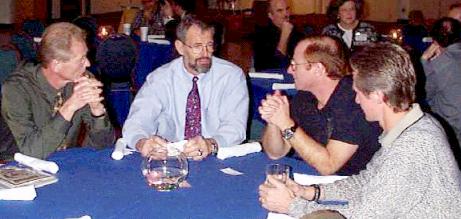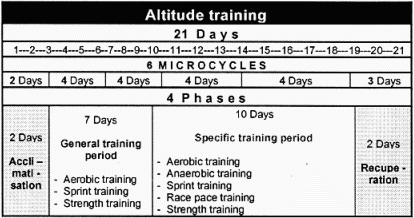SYMPOSIUM ON ALTITUDE TRAINING AND RESEARCH AT FLAGSTAFF Natalie B Harlan MA High Altitude Sports Training Complex, Northern Arizona University, Flagstaff, Arizona 86011-5769. Email: natalie.harlan@nau.edu Sportscience 3(2), sportsci.org/jour/9902/nbh.html, 1999 (1289 words) Reviewed
by Stephen Seiler PhD, Institute for Sport, Agder College, Kristiansand,
Norway
|
|
At our 1999 symposium in February, the High Altitude SportsTraining Complex at Northern Arizona University brought together manyrespected names in the field of exercise science, hypoxia research,and elite coaching. The three-day symposium was filled withback-to-back presentations and plenty of lively discussion, sparkedby four of our better-known participants: Benjamin Levine, associateprofessor of Medicine at the University of Texas Southwestern MedicalCenter and director of the Institute for Exercise and EnvironmentalMedicine at the Presbyterian Hospital in Dallas; John Hellemans,director of the New Zealand Triathlon Academy in Christchurch;Ørjan Madsen, director of the M/G Consulting Corporation inNorway and advisor to Olympiatoppen and the Norwegian SwimmingFederation; and Robert Chapman, head coach of Men’s CrossCountry/Distance at Indiana University. The goal of the symposium was to maximize the relationship betweenresearch and practical application. Attendees examined thephysiological effects of altitude on athletes and investigated howbest to utilize this form of specialized training to enhancecompetitive performance. A mix of international governing bodyrepresentatives, university faculty and students, physicians, coachesand athletes, all shared their data and theories on altitudetraining. Highlights from three of the presentations are providedhere.
Ben Levine presented The Dose-Response Relationship of HighAltitude: A Critical Appraisal of how High to Live and Train. DrLevine addressed acclimatization to high altitude, improvements ofoxygen transport and utilization at the cellular level, and how theseimprovements translate into enhanced endurance performance. He alsoexamined the challenge of predicting which athletes will fare poorlyin higher elevations, and presented strategies to prepare forcompetition at altitude. Dr Levine (along with Dr JimStray-Gundersen) has championed the Live High/Train Low model ofaltitude training and shared details of that pioneering study. Theirdata suggest that the physiological adaptations realized at altitudecan be advantageous to athletes, but high intensity workouts arebetter conducted at lower elevations to achieve improvedperformance. John Hellemans presented Intermittent Hypoxic Training: A PilotStudy. Dr Hellemans presented data suggesting that a new methodof altitude simulation, employing intermittent (interval) hypoxictraining, may be similar or even superior to conventional altitudetraining. The basic method involved exposing athletes to hypoxic air(9-11% oxygen) intermittently for five-minute intervals alternated bynormoxic air for five-minute intervals, for a total time of one houronce or twice a day for 15-20 days. Dr Hellemans’ resultssuggested an overall improvement in hematological factors related tooxygen transport and performance. Keynote speaker Ørjan Madsen’s presentation,Hypoxia--The Magic Pill to Enhance Performance in Endurance Sportsin the 21st Century, provided an intriguing and befittingculmination to the symposium. Dr Madsen pointed out several practicalissues to be considered when implementing altitude training.
In addition, Dr Madsen proposed several reasons for non-responseor negative response to altitude training: unstable health or lowaerobic performance at the start of the altitude training, too muchanaerobic work, lack of attention to the specific requirements duringthe acclimatization and re-acclimatization phases, insufficientrecuperation between high training loads, and poor nutrition. Finally, Dr Madsen addressed the challenges facing teams competingat the 2002 Salt Lake City Olympic Games. In particular, herecommended that competitors attempt to "identify the individualreduction of performance capacity at the specific altitude ofcompetition, and improve performance at that specific altitude bycarrying out enough altitude training at, and above, thisaltitude." The symposium included a total of 14 presentations, including thefollowing:
To order a copy of the Proceedings, which contains brieftranscriptions of all presentations, please contact the High AltitudeSports Training Complex at:www.nau.edu/hastc.We are now preparing for the 2000 Symposium of Sports Science.Updated information on that event will be posted regularly at thesame address. ©1999 |

